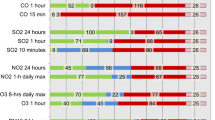Abstract
I SHOULD like to extend Brazell's recent discussion of the meteorological consequences of the Clean Air Act of 1956 which was confined chiefly to visibility and sunshine1. I shall provide further direct and indirect evidence concerning other meteorological variables such as atmospheric stability, solar radiation, illumination and air temperature, and the diverse interactions between meteorological elements and air pollution.
Similar content being viewed by others
References
Brazell, J. H., Nature, 226, 694 (1970).
Lawrence, E. N., Weather, 21, 367 (1966).
Dinsdale, F. E., Meteorol. Mag., 97, 314 (1968).
Lawrence, E. N., Weather (in the press).
Pivovarora, Z. I., Glav. Geof. Obs., Tr. Vyp., 233, 17 (Leningrad, 1968).
Lawrence, E. N., Meteorol. Mag., 98, 1 (1969).
Author information
Authors and Affiliations
Rights and permissions
About this article
Cite this article
LAWRENCE, E. Clean Air Act. Nature 229, 334–335 (1971). https://doi.org/10.1038/229334a0
Received:
Issue Date:
DOI: https://doi.org/10.1038/229334a0
- Springer Nature Limited





